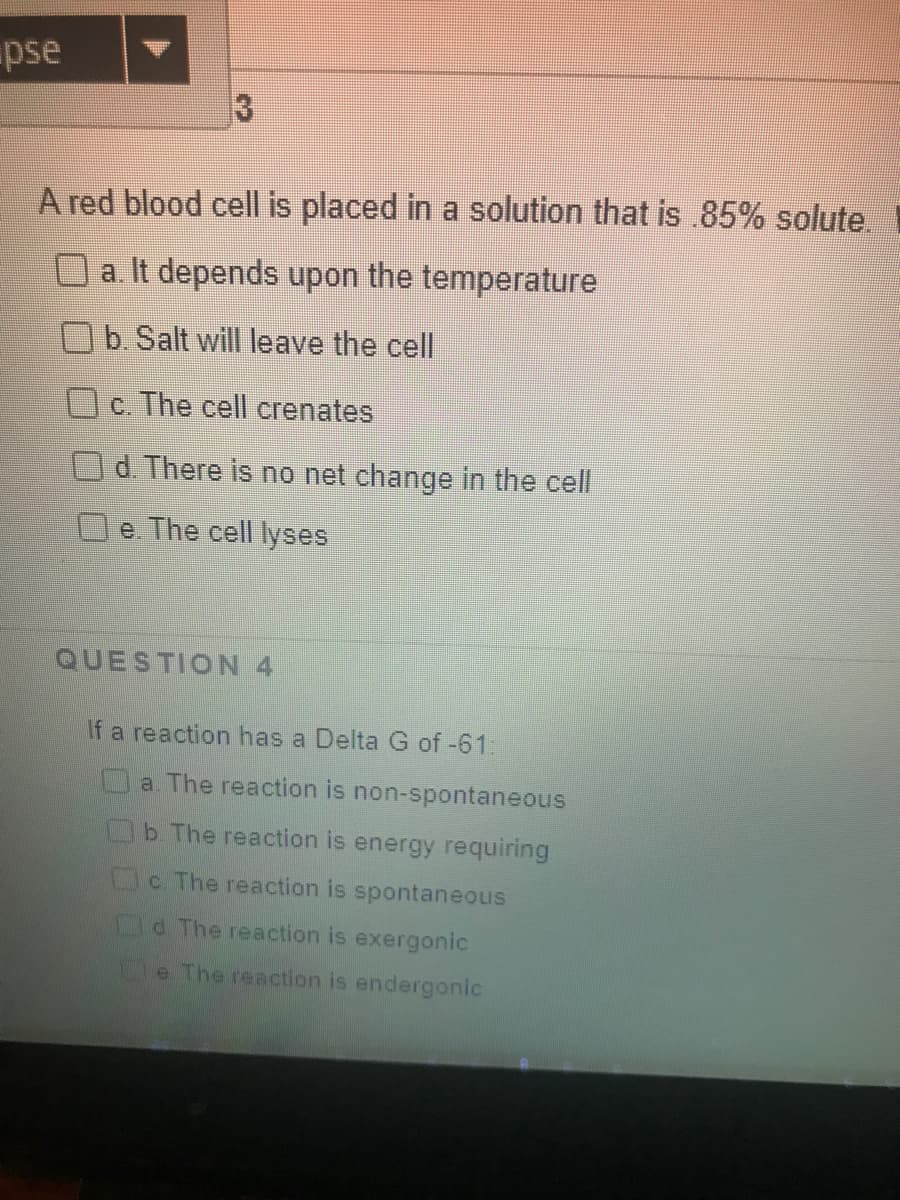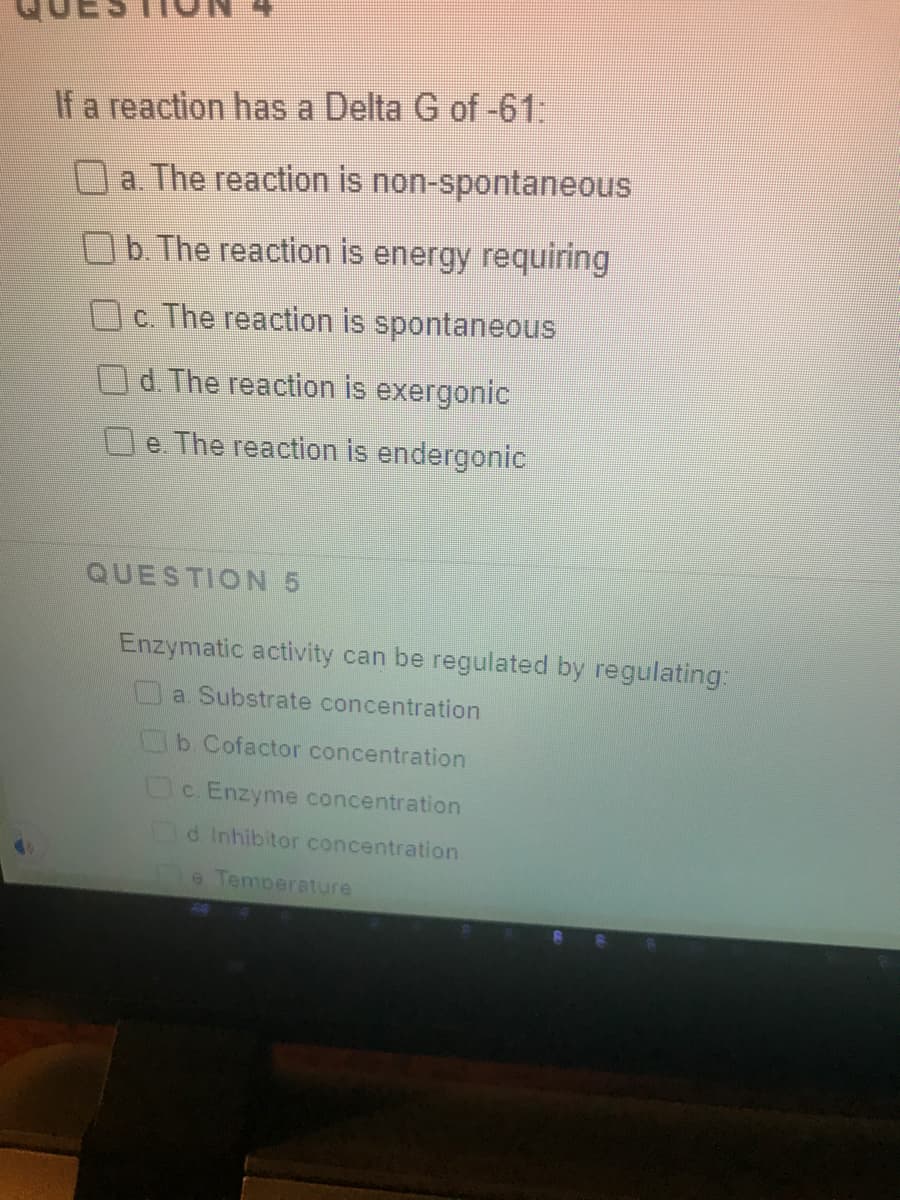A red blood cell is placed in a solution that is .85% solute. a. It depends upon the temperature O b. Salt will leave the cell O c. The cell crenates
A red blood cell is placed in a solution that is .85% solute. a. It depends upon the temperature O b. Salt will leave the cell O c. The cell crenates
Biology: The Unity and Diversity of Life (MindTap Course List)
15th Edition
ISBN:9781337408332
Author:Cecie Starr, Ralph Taggart, Christine Evers, Lisa Starr
Publisher:Cecie Starr, Ralph Taggart, Christine Evers, Lisa Starr
Chapter5: Ground Rules Of Metabolism
Section: Chapter Questions
Problem 9SQ: A molecule that donates electrons becomes ________, and the one that accepts the electrons becomes...
Related questions
Question

Transcribed Image Text:pse
A red blood cell is placed in a solution that is .85% solute.
O a It depends upon the temperature
b. Salt will leave the cell
c. The cell crenates
Od. There is no net change in the cell
e The cell lyses
QUESTION 4
If a reaction has a Delta G of -61:
a. The reaction is non-spontaneous
b The reaction is energy requiring
Oc The reaction is spontaneous
C.
Od The reaction is exergonic
Ge The reaction is endergonic

Transcribed Image Text:If a reaction has a Delta G of -61:
a. The reaction is non-spontaneous
b. The reaction is energy requiring
Oc. The reaction is spontaneous
O d. The reaction is exergonic
e The reaction is endergonic
QUESTION 5
Enzymatic activity can be regulated by regulating:
a Substrate concentration
b Cofactor concentration
Oc Enzyme concentration
d Inhibitor concentration
e Temperature
Expert Solution
This question has been solved!
Explore an expertly crafted, step-by-step solution for a thorough understanding of key concepts.
Step by step
Solved in 4 steps

Knowledge Booster
Learn more about
Need a deep-dive on the concept behind this application? Look no further. Learn more about this topic, biology and related others by exploring similar questions and additional content below.Recommended textbooks for you

Biology: The Unity and Diversity of Life (MindTap…
Biology
ISBN:
9781337408332
Author:
Cecie Starr, Ralph Taggart, Christine Evers, Lisa Starr
Publisher:
Cengage Learning

Biochemistry
Biochemistry
ISBN:
9781305577206
Author:
Reginald H. Garrett, Charles M. Grisham
Publisher:
Cengage Learning

Biology Today and Tomorrow without Physiology (Mi…
Biology
ISBN:
9781305117396
Author:
Cecie Starr, Christine Evers, Lisa Starr
Publisher:
Cengage Learning

Biology: The Unity and Diversity of Life (MindTap…
Biology
ISBN:
9781337408332
Author:
Cecie Starr, Ralph Taggart, Christine Evers, Lisa Starr
Publisher:
Cengage Learning

Biochemistry
Biochemistry
ISBN:
9781305577206
Author:
Reginald H. Garrett, Charles M. Grisham
Publisher:
Cengage Learning

Biology Today and Tomorrow without Physiology (Mi…
Biology
ISBN:
9781305117396
Author:
Cecie Starr, Christine Evers, Lisa Starr
Publisher:
Cengage Learning

Anatomy & Physiology
Biology
ISBN:
9781938168130
Author:
Kelly A. Young, James A. Wise, Peter DeSaix, Dean H. Kruse, Brandon Poe, Eddie Johnson, Jody E. Johnson, Oksana Korol, J. Gordon Betts, Mark Womble
Publisher:
OpenStax College